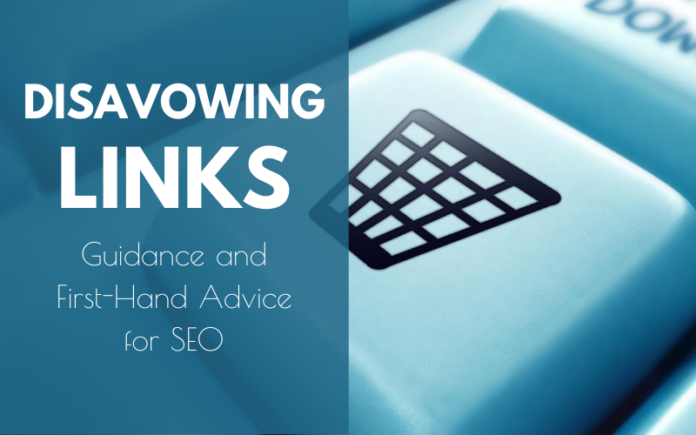Every content marketer wants high-quality inbound links going to their blog. Those backlinks can give you a huge boost when it comes to your SEO efforts, and help you climb SERPs faster.
But what about the bad backlinks? You know — the ones that come from spammy websites with low-quality content and weak domain authority. To help you remove these bad backlinks, Google developed a tool for disavowing links.
We created this guide to break down this feature. We’ll explain how Google’s link disavow tool works, list links you should consider disavowing, and share expert opinions on the process.
What Does Google’s Link Disavow Tool do?
Launched in 2012, Google’s disavow links tool allows you to ask Google to disregard selected backlinks. The purpose behind the disavow links tool is to essentially clean up your backlink profile and rid it of any spammy, low-quality backlinks that may lower your site’s search engine ranking.
Disavowing links is generally seen as a last resort that isn’t recommended for regular use. That’s because there’s always the risk that Google may penalize you if you accidentally disavow good backlinks or ones that weren’t causing any SEO problems. Most small to mid-sized businesses are unlikely to need this tool because they’re not dealing with large and complex link networks.
That said, if you’ve received a manual action message in Google Search Console that resembles the one below, it’s time to consider disavowing links.
 Source: Search Engine Land
Source: Search Engine Land
This warning from Google indicates there may be bad links, spammy links, or unnatural links to your site. They could be tied to link schemes: manipulation tactics designed to help you rank higher. These can include buying and selling links, high-volume link trading, and using programs to automatically bring links to your site.
To avoid getting this message, regularly check your backlinks and keep an eye out for suspicious links that may lead to negative SEO issues and force Google’s algorithm to lower your ranking. To get a better idea of what Google expects in terms of website quality, read over their webmaster quality guidelines.
If you do receive this message, disavow links to avoid getting penalized. To do this, access the disavow links tool in Google Search Console, select your website, and add a file with the links you want to disavow. Once you’ve taken those steps, Google will review the links and recrawl your site, which usually takes a few weeks.

Source: Google Search Console
After you’ve addressed the potential manual penalty and removed the backlinks, contact Google Search Console for a reconsideration request — a follow-up review of your site to make sure you disavowed links that were causing issues. You can also ask Google to recrawl your URLs so that new links and bad link removal are acknowledged.
To get a better understanding of your backlink profile, you can check the “Links to Your Site” section in Google Search Console. It shows what websites are linking to your content:

This information can help you identify spammy sites linking to your content. You can export this list and sort through the file to find all suspect links in your own disavow list and examine each of them carefully. This informal backlink audit will help you find all the shady backlinks that may result in an algorithmic penalty from Google.
5 Link Types you Should Consider Disavowing
Bad backlinks come in many different forms. Below are a few examples of the most common types to look out for. While this list doesn’t include all types of links you should disavow, it’s a good starting point.
Comment and Forum Spam Links
Google doesn’t necessarily frown upon users linking back to related content in comments or forums. However, it’s tough on webmasters that use forums to pad their backlink profile. If you go on reputable websites and try to flood their comment or forum sections with links back to your website and no additional context, Google will see it as spam and may penalize your site.
Expired Domain Links
Even if you have links that come from strong websites, they’re no good if they’re dead. At one point, maybe these were links from websites that you’d never dream of disavowing. Once they’re expired, however, all Google sees is a violation of their webmaster quality guidelines and can penalize you for them.
Low-Quality and Spammy Site Links
Spammy sites with lots of outbound links, or sites that appear to be hacked, may be worth disavowing. This could also be a sign that your site is being targeted by a negative SEO attack. If you don’t disavow these links, consider keeping an eye on the manual actions section of your Search Console dashboard to ensure no future action is needed.
Paid Links
Paid links are essentially backlinks to your site that you pay to receive. While they’re notoriously difficult to catch, there are ways to spot them. For example, if you see the term “sponsored post” on an article with dofollow links, that’s a paid link. However, paid links can be more subtle and appear in the form of dofollow links with exact match anchor text as well. That may not necessarily mean it’s a paid link, so check the site to ensure it isn’t full of spam or low-quality content.
Private Blog Network Links
Private blog networks (PBNs) are large groups of blogs and sites run by the same site owners to build backlinks between them and get their content to rank higher on Google. They were a big trend a few years back, but they’re no longer seen as a viable white hat SEO technique. In 2014, Google turned its back on PBNs and started taking steps toward de-indexing them altogether. A good way to spot them is if multiple sites have very similar backlink profiles or if one site is constantly being linked to. If you recognize any PBN links to your site, consider disavowing them.
3 SEO Experts’ Best Practices for Disavowing Links
If you notice a spammy link going to your site, don’t disavow it right away. According to Matt Cutts, a former distinguished engineer at Google, the first step is to reach out to someone at the website responsible for the backlink to get it removed manually.
While some people may respond to your request, there’s a strong chance you won’t hear back from many of these websites. If that happens, Alex Panagis, founder of SEO and marketing agency ScaleMath, says you can take a proactive or reactive approach to disavowing links.
A proactive approach entails regularly checking your backlinks to ensure they’re not coming from spammy, low-quality web pages. A reactive approach is using Google’s disavow links tool to minimize any negative SEO impact and you can follow the guide to start SEO business too.
Panagis says the reactive approach is more common for disavowing links. This is because Google is already incredibly good at understanding links. Unless you’re affected by a significant amount of spam that you spot before Google, there’s no immediate need to proactively seek out those bad backlinks.
That said, the proactive approach Panagis offers is also an option.
“Update your disavow file as you go to reduce the risk of your site ever being affected so that you never have to worry that the day will come when your site is suddenly affected,” says Panagis.
Update your disavow file as you go to reduce the risk of your site ever being affected so that you never have to worry that the day will come when your site is suddenly affected.CLICK TO TWEET
Jason Berkowitz, founder of inbound digital marketing agency Break the Web, says you also have to be extremely cautious when it comes to disavowing. He argues that disavowing good backlinks, even by accident, can negatively affect your search ranking. He only recommends disavowing links if the backlink is likely to have a negative consequence, like a traffic drop or manual penalty.
Panagis agrees with this sentiment.
“If you have a high-authority domain that naturally attracts a lot of links when the site is published, as long as the link profile is diverse and the majority isn’t spam, the need to disavow individually has never really presented itself,” says Panagis.
Boost Your Backlink Performance With Alexa
If you want to know whether disavowing links is right for your website, you need to start by checking your backlink profile. Alexa can help you find out how authoritative your backlink profile is and show you how many backlinks you’ve earned from top sites. #KhabarLive #hydnews








[…] Posted: Wed, 28 Oct 2020 10:17:00 GMT [source] […]
Comments are closed.